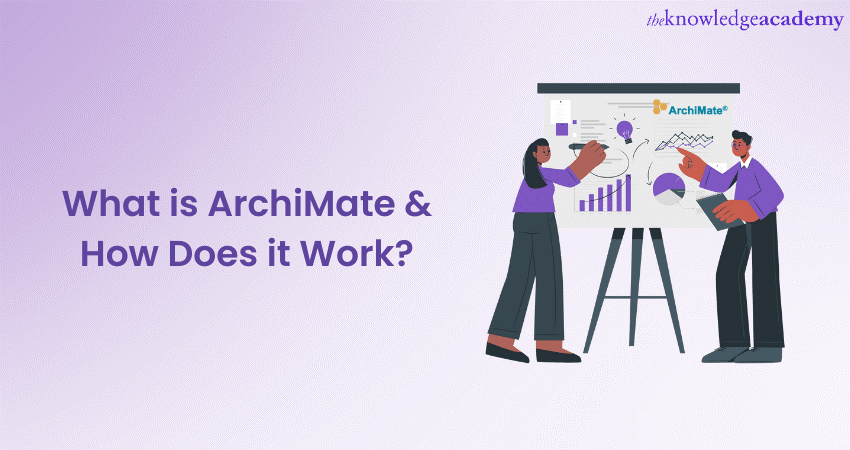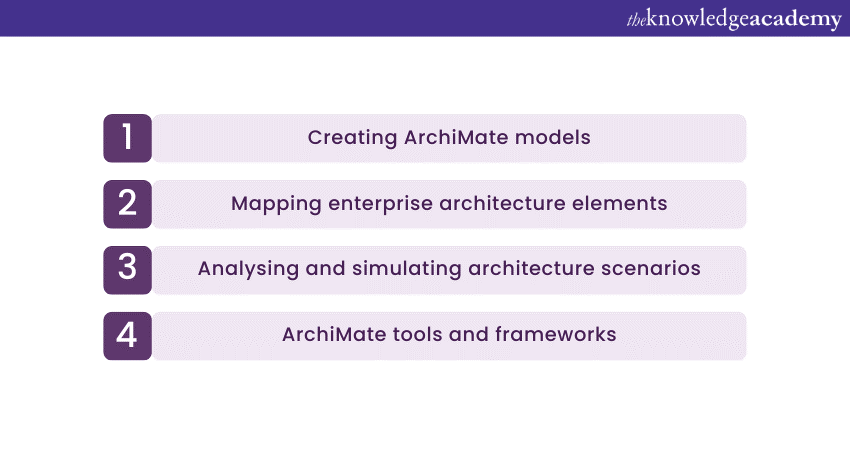We may not have the course you’re looking for. If you enquire or give us a call on 01344203999 and speak to our training experts, we may still be able to help with your training requirements.
Training Outcomes Within Your Budget!
We ensure quality, budget-alignment, and timely delivery by our expert instructors.

In today's rapidly evolving business landscape, enterprises face numerous challenges in managing their complex structures, processes, and technologies. Understanding the relationships between different organisational components is crucial for making informed decisions and driving strategic initiatives. This is where ArchiMate comes into play. This blog will delve deeper into What is ArchiMate, its purpose and how it works.
Table of Contents
1) What is ArchiMate?
2) What is the purpose of ArchiMate?
3) What are the key concepts of ArchiMate?
4) How does ArchiMate work?
5) Conclusion
What is ArchiMate?
ArchiMate is a powerful modelling language designed specifically for enterprise architecture. It provides a comprehensive framework for describing, visualising, analysing, and documenting complex business structures and processes. It helps organisations better understand their enterprise architecture and effectively communicate and align business and IT strategies.
At its core, ArchiMate focuses on capturing the relationships and dependencies between different elements of enterprise architecture, such as business processes, applications, and technology infrastructure. It enables stakeholders, including business executives, IT managers, and enterprise architects, to gain insights into the interdependencies and complexities of their organisation's structure and processes.
ArchiMate is based on a layered approach, dividing the enterprise architecture into different layers representing specific aspects of the organisation. Its three core layers are:
a) Business layer: This layer describes the organisation's strategy, objectives, functions, processes, and organisational structure. It focuses on the business aspects of the enterprise.
b) Application layer: This layer concentrates on the software applications and services used to support the organisation's business processes. It includes elements such as applications, interfaces, and components.
c) Technology layer: The technology layer deals with the infrastructure and technology components required to implement and operate the applications and services. It includes elements such as devices, systems, and networks.

What is the purpose of ArchiMate?
ArchiMate serves a vital purpose in enterprise architecture. Its key objectives are:
a) Describing and documenting: ArchiMate provides a structured approach to describe and document enterprise architecture, capturing complex relationships, components, and processes.
b) Communication and collaboration: Acting as a common language, it bridges the gap between business stakeholders and IT professionals, enabling effective communication and collaboration.
c) Analysis and decision-making: It facilitates the analysis of architectural decisions, risk assessment, and evaluation of alternative scenarios, leading to informed decision-making.
d) Business transformation support: ArchiMate assists organisations in modelling their architecture's current and target states, aiding in defining transformation roadmaps.
e) Alignment with industry standards: As an industry-standard modelling language, ArchiMate aligns with other frameworks and standards, ensuring compatibility and collaboration.
Join our ArchiMate 3 Training Course to learn ArchiMate modelling languages, metamodels, and relationships.
What are the key concepts of ArchiMate?
ArchiMate, as a modelling language for enterprise architecture, encompasses several key concepts:
a) Elements: ArchiMate defines various element types to represent components within the enterprise architecture, such as processes, applications, and technology components.
b) Relationships: These capture the dependencies and associations between elements, illustrating their interactions and connections.
c) Layers: ArchiMate employs a layered approach, including the Business, Application, and Technology Layers, to represent different perspectives of the enterprise architecture.
d) Viewpoints: These offer tailored perspectives on the architecture, focusing on specific stakeholder concerns and determining the relevant elements and relationships to be included.
e) Cross-cutting concepts: They capture recurring themes applicable across multiple layers, such as behaviour, structure, motivation, strategy, and integration.
These key concepts form the basis of ArchiMate, enabling stakeholders to effectively model, analyse, and communicate enterprise architecture.
Take your ArchiMate skills to the next level with our ArchiMate 3 Training Course: Level 2 – sign up today!
How does ArchiMate work?
ArchiMate works by providing a structured approach to modelling and visualising enterprise architecture. It enables organisations to describe and analyse their business processes, applications, and technology infrastructure consistently and standardised. Here's a step-by-step explanation of how it works:

Creating ArchiMate models
The first step in using ArchiMate is to create models representing the different layers of enterprise architecture. This involves identifying and defining the relevant elements within each layer, such as business processes, applications, and technology components. It provides a rich set of predefined features that can be used to model various aspects of an organisation.
Mapping enterprise architecture elements
Once the models are created, the next step is to map the relationships between the elements. This helps capture the enterprise architecture's dependencies, interactions, and hierarchies. ArchiMate provides a range of relationship types that establish connections between elements. For example, you can use the "composition" relationship to show how business processes are composed of smaller sub-processes.
Analysing and simulating architecture scenarios
ArchiMate allows organisations to analyse and simulate different architecture scenarios to assess their impact on the business. This can help identify potential risks, evaluate alternative solutions, and make informed decisions. By changing the elements and relationships in the models, organisations can visualise the potential effects of architectural changes before implementing them.
ArchiMate tools and frameworks
Several ArchiMate modelling tools are available in the market to facilitate the modelling and analysis process. These tools provide a user-friendly interface for creating, editing and managing its models. They also offer features such as automatic relationship validation, report generation, and integration with other enterprise architecture frameworks.
ArchiMate can be integrated with other popular enterprise architecture frameworks, such as TOGAF and Business Process Model and Notation (BPMN). This integration allows for a more comprehensive and cohesive approach to enterprise architecture management.
Unlock the power of ArchiMate with our ArchiMate 3 Training Course: Level 1 – sign up now!
Conclusion
We hope you enjoyed reading this informative blog on What is ArchiMate. It provides organisations a structured framework to describe, analyse, and manage their complex business structures and processes. With its key concepts of elements, relationships, layers, viewpoints, and cross-cutting concepts, it enables effective communication, collaboration, and decision-making across business and IT domains. By leveraging it, organisations can comprehensively understand their enterprise architecture, align strategies, support business transformation, and drive successful outcomes in a rapidly evolving business landscape.
Enhance your enterprise architecture expertise with our comprehensive ArchiMate 3 Training course – register now!
Frequently Asked Questions
Upcoming Business Improvement Resources Batches & Dates
Date
 ArchiMate® 3 Training Course
ArchiMate® 3 Training Course
Tue 28th May 2024
Mon 1st Jul 2024
Mon 28th Oct 2024







 Top Rated Course
Top Rated Course


 If you wish to make any changes to your course, please
If you wish to make any changes to your course, please


